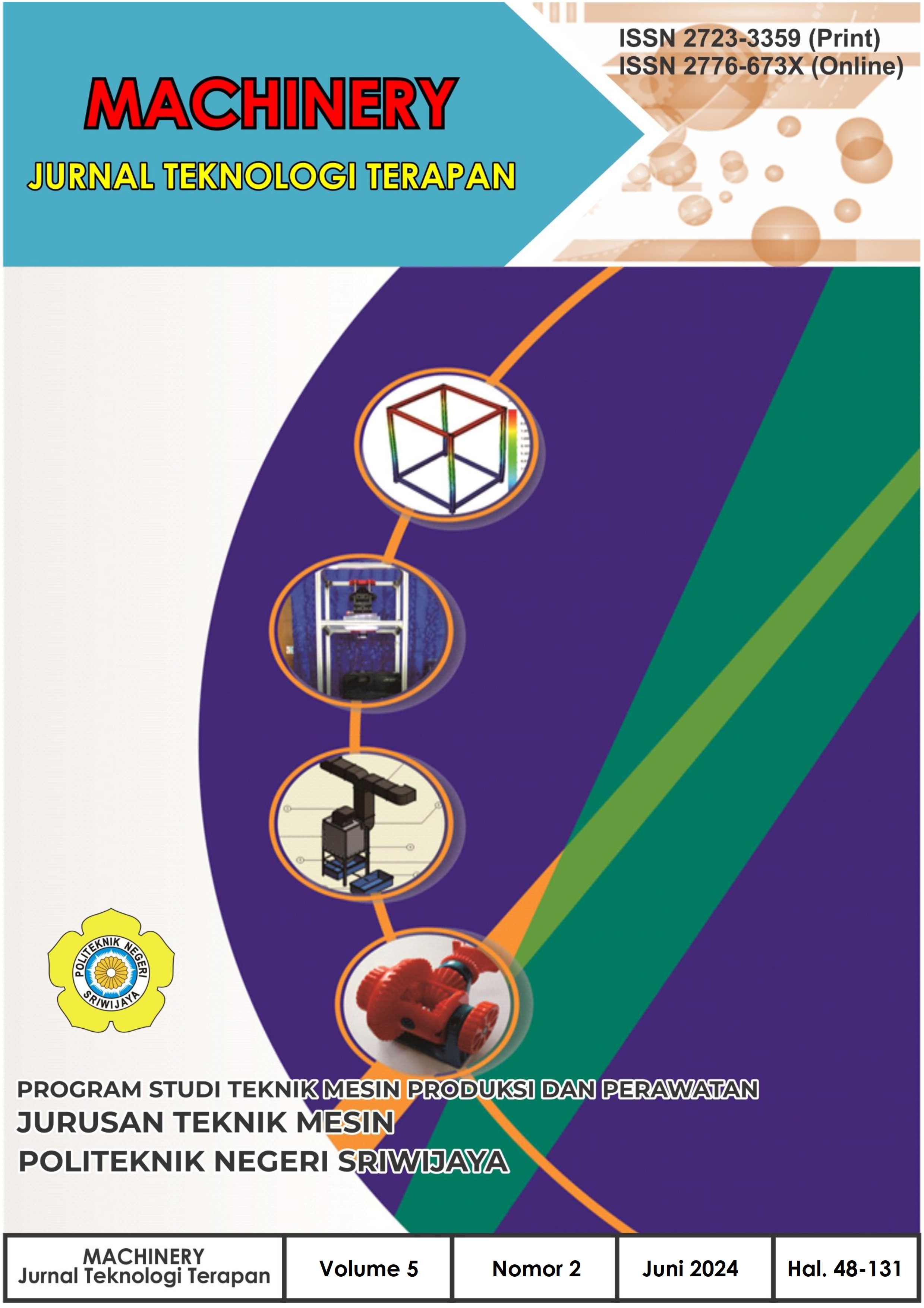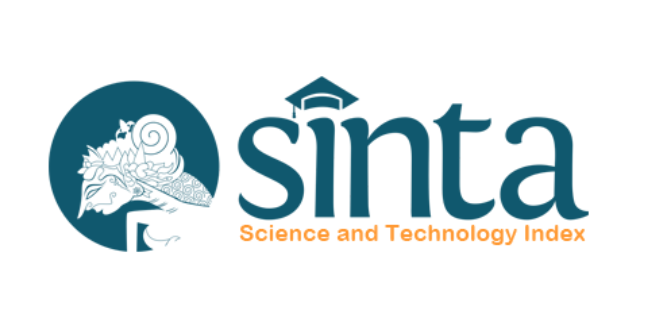PENGARUH SUHU DAN KECEPATAN MOTOR MESIN PULTRUSION TERHADAP DIAMETER FILAMEN 3D PRINTING
DOI:
https://doi.org/10.5281/zenodo.12736097Keywords:
: Cetak 3D, Filamen PET, Pultrusi, Regresi Non- LinearAbstract
3D printing technology enables the creation of 3D objects from 3D CAD designs using various types of thermoplastic materials, such as PLA, ABS, PET/-G, TPU, PP, and Nylon. Among these materials, PET stands out as an ideal choice for 3D printing applications due to its advantages, namely clarity and strength. The process of producing 3D objects involves the use of filaments that can be generated through either extrusion or pultrusion methods. While the pultrusion method with Arduino Uno control settings shows promise, further research is required to enhance the quality of the produced filaments. In this study, the filament production process involves process parameters, including temperatures of 140°C, 145°C, 150°C, and motor speeds of 75 rpm, 80 rpm, 85 rpm, and 90 rpm. Based on the research findings, the smallest filament diameter was observed at a temperature of 150°C and a motor speed of 90 rpm. Conversely, the largest filament diameter was found at a temperature of 140°C and a motor speed of 75 rpm with a nozzle diameter of 1.75 mm. The highest filament quality was achieved using a nozzle diameter of 1.6 mm, resulting in an average filament diameter of 1.75 mm. Through non-linear regression analysis, it can be concluded that each process parameter has a simultaneous impact on the filament diameter. The results of this study provide insights into optimizing process parameters in the pultrusion method to produce high-quality filaments in 3D printing technology.
Downloads
References
I. Apriansyah, A. Zamheri, and F. Arifin, “Peningkatan Akurasi Dimensi Dan Tingkat Kekerasan Pada Fillamen Esteel Dengan Pendekatan Metode Taguchi,†Mach. J. Teknol. Terap., vol. 2, 2020, doi: http://doi.org/10.5281/zenodo.474842 3.
D. Ardiyanto, “Uji Pengaruh Kecepatan dan Perbedaan Suhu antara Filament PLA dengan Filament PETG Pada 3D Printer Ender 5 PRO,†Politeknik Harapan Bersama Tegal, 2021.
Z. S. Suzen, Hasdiansah, and Yuliyanto, “Pengaruh Tipe Infill Dan Temperatur Nozzle Terhadap Kekuatan Tarik Produk 3D Printing Filamen Pla+ Esun,†J. Teknol. Manufaktur, vol. 12, no. 02, 2020.
R. Hakim, I. Saputra, G. P. Utama, and Y. Setyoadi, “Pengaruh Temperatur Nozzle dan Base Plate Pada Material PLA Terhadap Nilai Masa Jenis dan Kekasaran Permukaan Produk Pada Mesin Leapfrog Creatr 3D Printer,†J. Teknol. dan Ris. Terap., vol. 1, no. 1, pp. 1–8, 2019, doi: 10.30871/jatra.v1i1.1242.
M. F. A. R. Ghifari, S. Aisyah, and H. Toar, “Desain Mesin Filament Extruder,†J. Integr., vol. 14, no. 2, pp. 145–152, 2022, doi: 10.30871/ji.v14i2.4673.
H. Tondi, “Rancang Bangun Mesin Ekstruder Filamen 3D Printer,†Universitas Islam Indonesia Yogyakarta, 2019.
C. Mawardi, Pengantar 3D Printing. Jakarta: Polimedia, 2020.
K. Minchenkov, A. Vederkinov, A. Safonov, and I. Akhatov, “Thermoplastic Pultrusion: A Review,†Journals Polym., vol. 12, no. 3, 2021.
C. Budiantoro, H. S. B.Rochardjo, and G. Nugroho, “Effects of Processing Variables of Extrusion–Pultrusion Method on the Impregnation Quality of Thermoplastic Composite Filaments,†Journals Polym., vol. 12, no. 12, 2020.
F. E. Nugroho, F. Putri, and I. Gunawan, “Analisa Pengaruh Kemiringan Sudut Screw Extruder Terhadap Keakuratan Diameter Filament 3D Printer Berbahan Recycled Abs,Recycle Hdpe, Dan Polypropylene,†Mach. J. Teknol. Terap., vol. 4, no. 1, pp. 36–42, 2023, doi: doi.org/10.5281/zenodo.7684182.
S. L. Simanora, “Studi Tentang Implementasi 3d Printer Snapmaker Dalam Merancang Suatu Sampel Dasar Produk,†Universitas HKBP Nommensen, 2022.
Nawari, Analisis statistik dengan MS Excel 2007 dan SPSS 17 /. Jakarta: Elex Media Komputindo, 2010.
G. F. Utami, D. Suhaedi, and E. Kurniati, “Perbandingan Metode Regresi Linier dan Non-Linier Kuadratik Pada Peramalan Penjualan Air Minum,†J. Mat., vol. 20, no. 2, pp. 33–40, 2021.
Sujarwo, “Pemilihan Model Persamaan Regresi Dua Variabel Dengan Menggunakan Koefisien Korelasi Dan Nilai Mean Square Error,†J. Politek., vol. 14, no. 02, pp. 94–108, 2019.
Downloads
Published
How to Cite
Issue
Section
License
Copyright (c) 2024 Authors and Publisher

This work is licensed under a Creative Commons Attribution-NonCommercial-NoDerivatives 4.0 International License.
The Authors submitting a manuscript do so on the understanding that if accepted for publication, copyright of the article shall be assigned to MACHINERY: Jurnal Teknologi Terapan as publisher of the journal. Copyright encompasses rights to reproduce and deliver the article in all form and media, including reprints, photographs, microfilms, and any other similar reproductions, as well as translations.Â
MACHINERY: Jurnal Teknologi Terapan and the Editors make every effort to ensure that no wrong or misleading data, opinions or statements be published in the journal. In any way, the contents of the articles and advertisements published in MACHINERY: Jurnal Teknologi Terapan are the sole responsibility of their respective authors and advertisers.








